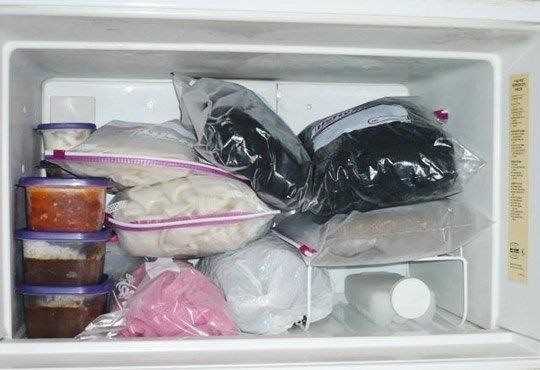




Putting clothes in the freezer may seem like an unusual method of caring for your garments, but it can actually be a beneficial practice. This technique is particularly effective for certain types of clothing and can help to address specific issues such as odors and stains. In this article, we will explore why freezing clothes can be helpful and provide step-by-step instructions on how to do it effectively.
Why should you put clothes in the freezer?
There are several reasons why freezing clothes can prove to be advantageous. Firstly, freezing can help to eliminate unwanted odors that may have become trapped in the fabric. This is especially useful for clothes that have been in storage for a long period of time or garments that have absorbed the smell of smoke or other strong odors. Additionally, freezing can also be an effective method for removing certain types of stains, such as those caused by grease or oil.
Furthermore, freezing clothes can help to kill bacteria and other microorganisms that may be present on the fabric. This can be particularly beneficial for individuals with sensitive skin or allergies, as it can reduce the risk of irritation or allergic reactions. Freezing clothes can also be a useful strategy for combating pests, such as moths, that may damage textiles.
How to put clothes in the freezer?
Putting clothes in the freezer is a simple process that can be done with minimal effort. Follow these steps to freeze your garments effectively:
- Prepare the clothes: Before placing the clothes in the freezer, ensure that they are clean and dry. If necessary, spot clean any stains before freezing.
- Bag the clothes: Place the clothes in a sealable plastic bag or airtight container. This will protect them from freezer burn and help to contain any odors.
- Freeze the clothes: Put the bag or container in the freezer and leave it for a minimum of 24 hours. This will give sufficient time for the low temperatures to work their magic.
- Remove and thaw: Take the clothes out of the freezer and let them thaw at room temperature. Once thawed, you can proceed to wash or wear the garments as usual.
By following these simple steps, you can utilize the power of freezing to effectively care for your clothes and address various issues. Whether you are dealing with unwanted odors, stubborn stains, or simply want to ensure that your garments are clean and fresh, freezing can be a practical and affordable solution.
Benefits of Freezing Clothes
Freezing clothes can be a useful technique for various reasons. Here are some benefits of freezing clothes:
- Killing bacteria and odors: Freezing clothes can help kill bacteria and eliminate unpleasant odors. Cold temperatures can inhibit the growth of bacteria and neutralize odorous substances present in the fabric.
- Preserving delicate fabrics: Delicate fabrics such as silk, cashmere, and lace can be susceptible to damage or shrinkage when washed. Freezing these clothes can help preserve their shape, texture, and color.
- Removing stains: By freezing stained clothes, you can prevent the stain from setting further into the fabric. After freezing, you can proceed with the stain removal process, increasing the chances of successful stain removal.
- Preventing moth infestation: Freezing clothes can act as a natural moth deterrent. Moths and their larvae are unable to survive in freezing temperatures, so freezing clothes can help eliminate these pests and prevent future infestations.
It is important to note that freezing clothes alone may not always be sufficient for thorough cleaning. In many cases, freezing can be a complementary method used in combination with washing or dry cleaning to achieve the best results.
Preserving Fabrics: Freezing as a Natural Method
Preserving fabrics is an important part of maintaining their quality and prolonging their lifespan. While there are various methods available, freezing is a natural and effective way to preserve fabrics. It can help protect delicate fabrics, prevent fading, and eliminate unwanted odors.
Why Freeze Fabrics?
Freezing fabrics works by killing bacteria and moths that may be present in the fabric. It can also help remove any unwanted smells, such as body odors or smoke, without the need for harsh chemicals. Additionally, freezing fabric can help prevent fading and discoloration, especially in delicate or vintage fabrics.
How to Freeze Fabrics
To freeze fabrics, follow these simple steps:
- Clean the fabric: Before freezing, make sure the fabric is clean. Remove any stains or dirt by spot cleaning or washing, depending on the fabric type and care instructions.
- Fold the fabric: Fold the fabric neatly to minimize wrinkles and maximize space in the freezer. If the fabric is too large, you can cut it into smaller sections.
- Place in a freezer-safe bag: Put the folded or cut fabric into a freezer-safe bag, ensuring it is airtight to prevent any moisture from entering.
- Label and date the bag: It’s important to label and date the bag, especially if you have multiple fabrics in the freezer. This will help you keep track of when the fabric was frozen.
- Store in the freezer: Finally, place the fabric in the freezer. Make sure it is laid flat and not stacked on top of other items to avoid unnecessary pressure.
Thawing and Care

When you’re ready to use the frozen fabric, remove it from the freezer and allow it to thaw at room temperature. Once thawed, handle the fabric gently and avoid wringing or stretching it. Follow the specific care instructions for the fabric type, whether it requires hand washing, dry cleaning, or machine washing.
Conclusion
Freezing fabrics is a natural and effective method for preserving them. Whether you’re storing delicate fabrics, vintage pieces, or simply looking to eliminate odors, freezing can help maintain their quality and prolong their lifespan. By following a few simple steps, you can easily freeze fabrics and enjoy their benefits for years to come.
Preventing Insect Infestations: Using Cold to Ward Off Bugs

Keeping your clothes and textiles safe from insect infestations is an essential part of maintaining the longevity and cleanliness of your wardrobe. One effective and natural way to prevent bugs from damaging your clothes is by using cold temperatures. Freezing your garments can kill bugs and their eggs, ensuring that your clothes remain bug-free and in good condition.
Why Use Cold to Prevent Insect Infestations
There are several reasons why using cold temperatures is an effective method to ward off bugs:
- Natural approach: Using cold temperatures is a chemical-free and natural way to prevent insect infestations. It does not involve the use of harmful chemicals or pesticides, making it a safe option for both you and your clothes.
- Kills bugs and eggs: Cold temperatures can effectively kill bugs at all stages of their life cycle, including eggs. Freezing your clothes can eliminate any existing bugs or eggs, preventing them from causing further damage or spreading to other garments.
- No damage to fabrics: Unlike other methods, such as heat treatment or chemical treatments, cold temperatures do not damage fabrics. Freezing your clothes will not cause any shrinkage, discoloration, or other negative effects on the quality and appearance of your garments.
How to Use Cold to Prevent Insect Infestations
Follow these steps to use cold temperatures effectively in preventing insect infestations:
- Identify infested garments: Inspect your clothes for any signs of insect infestations, such as holes, larvae, or droppings. Identify the garments that need to be treated to prevent further damage.
- Seal garments: Place the infested garments in a sealable plastic bag or container. Ensure that there are no openings or gaps, as bugs can escape or enter through these spaces.
- Freeze for at least 48 hours: Put the sealed garments in your freezer and leave them inside for at least 48 hours. The low temperatures will kill the bugs and their eggs, ensuring that they are no longer a threat to your clothes.
- Thaw and inspect: After the freezing period, remove the garments from the freezer and allow them to thaw naturally at room temperature. Once thawed, inspect the clothes to ensure that there are no signs of bugs or infestations.
- Store properly: Once you have confirmed that the garments are bug-free, store them properly in a clean and airtight space, such as a drawer or a wardrobe, to prevent future infestations.
Conclusion
Using cold temperatures is an effective and natural method to prevent insect infestations in your clothes. Freezing your garments kills bugs and their eggs without causing any damage to the fabric. By following the steps outlined in this article, you can ensure that your clothes remain bug-free and in pristine condition for years to come.
How to Freeze Clothes Properly
Step 1: Choose the Right Clothes

Not all clothes can be successfully frozen, so it’s important to choose the right ones. Generally, clothes made of natural fibers like cotton, linen, or wool can be frozen without any issues. However, clothes with delicate embellishments, sequins, or leather details may not fare well in the freezer.
Step 2: Clean the Clothes
Before freezing, make sure the clothes are clean. Dirty clothes can attract insects or develop odors during freezing, so it’s important to wash or dry clean them beforehand.
Step 3: Fold the Clothes

To maximize space and minimize wrinkles, fold the clothes neatly before placing them in the freezer. This will also help them freeze evenly.
Step 4: Place in a Resealable Bag
Put the folded clothes inside a resealable plastic bag. Squeeze out as much air as possible before sealing the bag. This will prevent freezer burn and help maintain the quality of the clothes.
Step 5: Store in the Freezer
Find a spot in your freezer where the clothes can lie flat without being crushed. Ideally, lay them on a flat shelf or stack them on top of each other. Make sure they are not in direct contact with any food items or wet surfaces.
Step 6: Thaw the Clothes Properly
When you’re ready to use the frozen clothes, remove them from the freezer and let them thaw naturally at room temperature. Avoid using heat sources like a microwave or dryer to thaw them, as this can cause damage to the fabric.
Step 7: Refresh the Clothes
After thawing, you may notice that the clothes have a slightly wrinkled or stiff appearance. To refresh them, hang them up in a steamy bathroom or lightly mist them with water before wearing or ironing.
Step 8: Monitor for Any Changes
Occasionally, frozen clothes may experience slight changes in texture or color. Monitor the clothes closely after thawing and check for any damage or unwanted changes. If you notice any issues, it might be best to avoid freezing clothes in the future.
By following these steps, you can effectively freeze your clothes and help extend their lifespan. Whether you’re storing seasonal items or preserving delicate garments, freezing clothes properly can be a useful technique for maintaining their quality.
Selecting the Right Clothing Items for Freezing
When it comes to freezing clothes, not all items are suitable for this method. Here are some tips on selecting the right clothing items to put in the freezer:
Material
Choose clothing items made of materials that can withstand freezing temperatures without being damaged. Materials such as cotton, wool, and polyester are generally safe to freeze. However, delicate fabrics like silk or satin may not be suitable for freezing.
Cleanliness
Make sure the clothing items you plan to freeze are clean. Stains or dirt can set in when exposed to freezing temperatures, making them harder to remove later.
Moisture
Avoid freezing clothing items that are wet or damp, as this can cause them to develop mould or mildew. Ensure that the items are completely dry before placing them in the freezer.
Size and Shape
Consider the size and shape of the clothing items when selecting which ones to freeze. Ensure that they can fit comfortably in your freezer without being squished or deformed.
Type of Clothing

Some types of clothing can benefit more from freezing than others. Items such as jeans, sweaters, and jackets tend to respond well to freezing, as the cold temperature can help eliminate odours and kill bacteria. However, freezing may not be as effective for items like socks, underwear, or t-shirts.
Storage Bags
Use airtight storage bags or containers when freezing clothing items to prevent them from getting damaged by moisture or odours from other foods in the freezer. Ziplock bags or vacuum-sealed bags can work well for this purpose.
Labeling
Consider labeling the storage bags or containers with the date and contents of the clothing items. This can help you keep track of how long they have been in the freezer and make it easier to find specific items when you need them.
By following these tips, you can ensure that the clothing items you choose to freeze will stay fresh and clean. Happy freezing!
Preparing Clothes for Freezing: Cleaning and Packaging
Clean the Clothes
Before you put your clothes in the freezer, it is important to clean them thoroughly. The freezer is not a substitute for washing and will not remove dirt or stains from your clothes. To ensure that your clothes stay fresh and free from any dirt or bacteria while in the freezer, make sure to follow these steps:
- Sort your clothes by color and fabric type.
- Read the care labels to determine the appropriate cleaning method for each garment.
- Pre-treat any visible stains using a stain remover or a detergent.
- Wash your clothes according to the care instructions.
- Allow your clothes to dry completely before proceeding to the next step.
Package the Clothes
Once your clothes are clean and dry, you can proceed to package them for freezing. Proper packaging will help protect your clothes from moisture and odors. Here are some steps to follow:
- Fold your clothes neatly to minimize wrinkles.
- Place each garment in a sealable plastic bag or airtight container. Make sure to remove as much air as possible from the bag or container before sealing.
- You can also use vacuum-sealed bags to save space.
- Label each bag or container with the contents and the date of freezing.
- If you are freezing delicate items like silk or lace, consider wrapping them in acid-free tissue paper before packaging them.
By following these steps, you can ensure that your clothes are properly prepared for freezing. This will help maintain their quality and extend their lifespan when stored in the freezer.
Tips for Freezing Clothes Efficiently
- Sort and Label: Before freezing your clothes, sort them by category (e.g., shirts, pants, sweaters) and label each bag accordingly. This will make it easier to find specific items later.
- Use Airtight Containers or Bags: Place your clothes in airtight containers or bags to prevent moisture and odors from seeping in. This will help keep your clothes fresh and ready to wear when you take them out of the freezer.
- Remove Excess Air: When using freezer bags, squeeze out as much air as possible before sealing. This will help reduce the risk of freezer burn and maximize storage space.
- Consider Vacuum Sealing: If you have a vacuum sealer, use it to remove even more air from the bags. This method will provide the best protection against freezer burn and save even more space.
- Freeze in Small Batches: Instead of freezing all your clothes in one large container, divide them into smaller batches. This will make it easier to access specific items without having to thaw everything.
- Organize and Stack: Once your clothes are properly packaged, organize them in your freezer by category or usage frequency. Stack them neatly to optimize storage space and make it easier to find what you need.
- Keep a Freezing Schedule: If you frequently rotate your wardrobe or have seasonal clothing, create a freezing schedule to keep track of when to remove and store items. This will help you stay organized and prevent overcrowding your freezer.
- Keep the Temperature Consistent: Ensure that your freezer maintains a consistent temperature of 0°F or below. Fluctuations in temperature can affect the quality and longevity of your frozen clothes.
FAQ
Why would I want to put clothes in the freezer?
There are a few reasons why you might want to put clothes in the freezer. One common reason is to remove unpleasant odors. Freezing can help neutralize the odor-causing bacteria present in clothes. Another reason is to kill bed bugs or other pests that may be hiding in your clothes. Freezing can be an effective method to eradicate these pests without using any chemicals.
How do I put clothes in the freezer?
To put clothes in the freezer, start by placing the items in a sealable plastic bag. Make sure to squeeze out as much air as possible from the bag before sealing it. Then, find a spot in your freezer where you can lay the bag flat without it being squished. Leave the clothes in the freezer for a few hours or overnight. Once they have been frozen, remove them from the freezer and let them thaw before wearing or using them.
Can I put any type of clothing in the freezer?
Most types of clothing can be safely put in the freezer. However, it’s important to check the care instructions on the clothing label to ensure it is suitable for freezing. Delicate fabrics or those with embellishments may not be suitable for freezing as it can cause damage. Additionally, items with leather or fur should not be frozen. It’s always best to err on the side of caution and avoid freezing expensive or delicate items.
How long should I leave my clothes in the freezer?
The length of time you should leave your clothes in the freezer can vary depending on the purpose. To remove odors, a few hours should be sufficient. For killing bed bugs or other pests, it is recommended to leave the clothes in the freezer for at least 24 hours to ensure the pests are effectively eliminated. If you’re unsure, it’s always better to err on the side of leaving them in the freezer for a bit longer.














